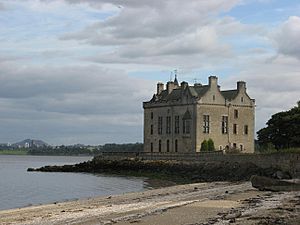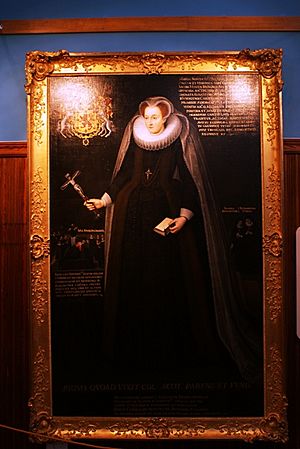Gilbert Curle facts for kids
Gilbert Curle (died 1609) was a Scottish secretary who worked for Mary, Queen of Scots when she was held captive in England. He married Barbara Mowbray, who was one of three sisters serving Mary.
Contents
Gilbert Curle's Early Life and Role

We don't know much about Gilbert Curle's family, but he seemed to be from Edinburgh. In 1567, Mary, Queen of Scots, wanted Curle to work for her as a valet (a personal attendant).
Gilbert Curle was with Mary in England starting in September 1568. He worked as her secretary, helping with letters written in the Scots language. By the 1580s, people writing to Mary often added notes for Curle in their letters.
In December 1581, Mary asked for horses for her staff to ride with her. She was allowed four horses for her men, but they couldn't carry pistols. The riders chosen were Andrew Melville, Claude Nau, Gilbert Curle, and Bastian Pagez.
Gilbert's sister, Elizabeth Curle, also joined Mary's household.
Curle sometimes wrote letters using code words. For example, "merchant of London" meant Elizabeth I, "merchant of Newcastle" meant Mary, and "merchant's wife" meant Francis Walsingham.
Gilbert Curle's Marriage at Tutbury Castle

Gilbert Curle married Barbara Mowbray, who was one of Mary's ladies-in-waiting. Barbara was the daughter of John Mowbray, who owned Barnbougle Castle in Scotland. Her mother was Elizabeth Kirkcaldy, sister of William Kirkcaldy of Grange.
In December 1580, Barbara's father, John Mowbray, was in contact with Francis Walsingham. This happened after one of his sons, Francis, met Walsingham in London.
A secret letter to the French ambassador, Michel de Castelnau, mentioned Barbara Mowbray or one of her sisters joining Mary's household. This letter was found and decoded in 2023. Curle, Nau, and Jérôme Pasquier helped Mary write letters in code.
Planning the Wedding
The marriage was talked about in October 1584. Ralph Sadler told Francis Walsingham that Gilbert and Barbara had asked Barbara's father for permission to marry. Mary, Queen of Scots, had asked Sadler to help send the letter quickly.
Around this time, Curle went to see Tutbury Castle to check the rooms before Mary moved there. He said the rooms were in bad shape. Sadler thought Curle was lying and called him a "false Scot." However, Sadler and John Somer later agreed that Curle was right about the broken windows in the main tower. They thought Mary's household didn't want to move for "secret reasons."
Many new furnishings were needed for Tutbury Castle. John Somer said that Nau and Curle kept asking him daily for horses for Mary. He thought Mary wanted to send Curle to Scotland as a messenger.
October Wedding Ceremony
Gilbert Curle and Barbara Mowbray got married at Tutbury Castle on October 23, 1585. Mary had promised them a gift of 2000 French crowns. They gave this money to Mary's French secretary, Claude Nau. Amias Paulet, who was Mary's keeper at Tutbury, knew they were engaged. But he wrote to Walsingham after the wedding, saying Mary had not told him about the ceremony beforehand.
Barbara's Sister Arrives
Barbara's sister, Geillis Mowbray, came to England from Barnbougle too late for the wedding. Mary wrote to Francis Walsingham on September 30, 1585, asking for Geillis's travel papers from London. Geillis arrived at Tutbury on November 9. She first worked as a maid for Curle's sister, Elizabeth. Geillis Mowbray is believed to have received jewels from Mary, known as the "Penicuik jewels," which are now displayed at the National Museum of Scotland.
Curle's Arrest
Barbara Curle was pregnant in May 1586. She and Gilbert eventually had eight children. Gilbert Curle was arrested before their daughter was born in August 1586. Mary wanted the baby to be named after her, but there was no priest available for a baptism.
Arrest and Life After Mary

Gilbert Curle and Claude Nau were arrested and taken to London on August 4, 1586. They were suspected of being involved in the Babington plot, a plan to overthrow Queen Elizabeth I. Queen Elizabeth thought neither Nau nor Curle would try to harm themselves. Francis Walsingham asked Mary's keeper, Amias Paulet, to move Mary from Chartley Castle and arrest her two secretaries. Mary was taken to Tixall, and Barbara Curle had her baby while Mary was away.
Evidence against Mary and her secretaries was collected by a code-breaker named Thomas Phelippes. Phelippes hoped Nau and Curle would be hanged. Their work was used as evidence at Mary's trial. They were also questioned to prove that Mary had dictated the letters they had written and put into code. Curle said he warned Mary not to reply to Babington's letters.
During his time in prison, Gilbert's mother, Elizabeth Curle, wrote from Barnbougle to the Scottish ambassador in London, Archibald Douglas, asking for his help. His sister Janet Curle also wrote to him, hoping Queen Elizabeth would release him.
In September 1586, Walsingham sent news to the Scottish Court that Mary would be moved to Fotheringhay. He said that the evidence against her was clear and that her two secretaries had confessed.
When Mary's household moved to Fotheringhay, Gilbert Curle's wife Barbara, his sister Elizabeth, his sister-in-law Geillis Mowbray, and his servant Lawrence stayed at Chartley. At Fotheringhay, Jane Kennedy and Elizabeth Curle helped Mary onto the scaffold for her execution. Kennedy tied Mary's blindfold. Mary had chosen Jane and Elizabeth for this duty.
After his release, Gilbert Curle went to France and then settled in the Spanish Netherlands. Around 1589, Geillis Mowbray, who had returned to Scotland, and her husband Sir James Lyndsey, and her sister Jean Mowbray, received money from Spain.
Death and Memorial
Gilbert Curle died on September 3, 1609, possibly in Madrid. Barbara died in Antwerp on July 31, 1616. Gilbert's sister, Elizabeth Curle, died on May 29, 1620.
Barbara Mowbray's son, Hippolytus Curle, and Elizabeth Curle had a monument built in the church of St Andrew in Antwerp. This monument includes a portrait of Queen Mary. The portrait was painted on copper by Frans Pourbus the Younger (1569-1622).
Hippolytus Curle also gave a special religious item, an "Agnus Dei," to the Scots College at Douai. He also gave them the memorial portrait of Mary, which is now kept by Blairs College Museum in Aberdeen.
Elizabeth Curle and Mary's Jewels
After Mary, Queen of Scots, was executed in 1587, a list was made of her jewels. Many pieces were listed as being with Gilbert's sister, Elizabeth Curle. These included:
- A chain made of coral and gold beads with pearls.
- A chain of small pearls.
- A chain of amber with small pearls.
- A gold "book" with pictures of Mary, her husband Lord Darnley, and their son James VI.
- A gold ring with a ruby.
- A diamond ring.
- A ring made of mother of pearl with a blue sapphire.
- A gold spear and a gold tree with a queen on top.
- A silver mirror.
Mary had asked Elizabeth to give Barbara Curle a gold item showing one of Aesop's fables and two rings, one with a diamond. She also wanted Elizabeth to give Curle's youngest child two rings and a small chain.
Elizabeth Curle also had Mary's silver items, like two small silver containers, two cups with silver, and a small silver bell. She also had two more mirrors and several watches. She had money for one of her sisters and for Gilbert Curle's servant, Lawrence.
Elizabeth also had some of Mary's clothes, including a silk gown, a black skirt, a russet satin jacket, and a beaver felt hat. She was keeping a velvet cloak and a white satin jacket for Barbara Curle, and a satin skirt for Curle's child.

